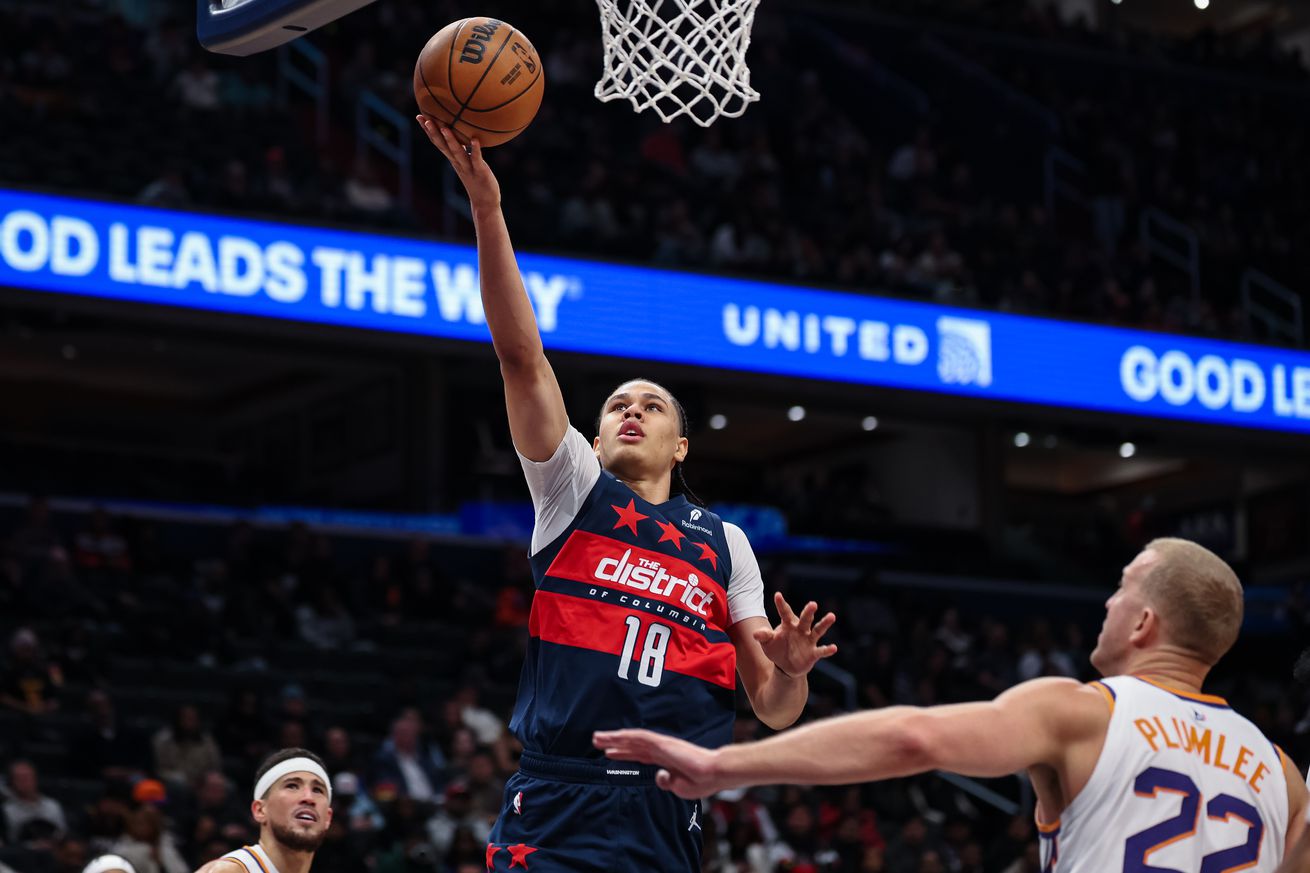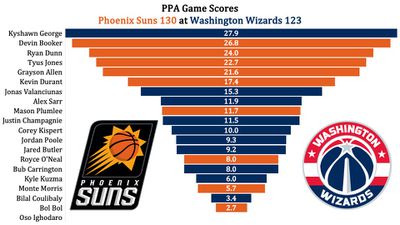
Stats, commentary, analysis
This game had the hallmarks of yet another Wizards stomp loss. The Phoenix Suns jumped out to an early lead (up 13 at the end of the first quarter), maintained it in the second quarter, and then seemed to blow things open with a dominating third quarter. Phoenix never trailed in the game and built their lead to as much as 24 points.
And then, trailing by 21 after three quarters, head coach Brian Keefe broke out the secret weapon, two-way player Jared Butler. For those who missed the past few weeks (you could be forgiven), Butler’s been on something of a binge. In this game, his personal numbers weren’t gaudy, but the Wizards were +14 in the fourth quarter with Butler playing all 12 minutes.
The final quarter was notable for a few reasons:
- Neither Kyle Kuzma nor Jordan Poole played even a second.
- The team leaders in fourth quarter minutes were Butler and Corey Kispert (12 minutes each), Kyshawn George (11:42), Bilal Coulibaly (6:13), Alex Sarr (6:13), Justin Champagnie (6:05), and Jonas Valanciunas (5:47).
- The team’s closing lineup was Butler (24 years old), Kispert (25), George (21), Coulibaly (20), and Sarr (19).
Now, the young lineup did make some mistakes in the closing stages. For example, after nailing a three to bring the Wizards to within three points with 1:06 left to play, George played deer in the headlights defense and ball-watched Tyus Jones and lost track of his man — Devin Booker — who pushed the lead back to six with the wide-open three.
Teachable moment.
Bright spots?
- George played the best game of his young career — 24 points on 8-10 shooting, including 6-8 from three-point range. He added 3 rebounds, 4 assists and a steal. He also fouled out after committing some “stop the clock” fouls late.
- Jonas Valanciunas dominated inside in his 15 minutes of action — 11 points on 6 shots and 8 rebounds. The team was +9 with him on the floor.
- Alex Sarr had a tough shooting night from three (he missed his first six attempts before finally connecting late), but he threw down some nice dunks, and had 9 rebounds, a steal and 2 blocks.
- Justin Champagnie made the case (yet again) for more playing time, this time scoring 10 points on 6 shots in just 10 minutes.
- Corey Kispert was 0-3 from three-point range but made his mark on offense with drives, cuts, and playmaking. He had five assists to two turnovers.
- Butler played an excellent fourth quarter — 6 points on 4 shots, 2 rebounds, 2 assists, 2 steals and a block. He worked on defense and avoided turnovers and bad shots.
Just spots?
- Kuzma did not play well (5 points, 5 rebounds 5 assists, 2 steals, 3 turnovers in 27 minutes), but he minimized the offensive damage by keeping his usage to just 17.1%. The defense? Yikes. The team defensive rating was 139.6 during his minutes — worst in the game for Washington.
- Not one of Poole’s better games — 18 points on 6-16 shooting, 3-10 from three. He did contribute 4 rebounds, 4 assists, and a couple steals. He also committed five fouls.
- Former Wizards guard Bradley Beal, who’s been coming off the bench for Phoenix the previous six games, missed last night’s contest with an ankle injury.
Four Factors
Below are the four factors that decide wins and losses in basketball — shooting (efg), rebounding (offensive rebounds), ball handling (turnovers), fouling (free throws made).
Stats & Metrics
Below are a few performance metrics, including the Player Production Average (PPA) Game Score. PPA is my overall production metric, which credits players for things they do that help a team win (scoring, rebounding, playmaking, defending) and dings them for things that hurt (missed shots, turnovers, bad defense, fouls).
Game Score (GmSC) converts individual production into points on the scoreboard. The scale is the same as points and reflects each player’s total contributions for the game. The lowest possible GmSC is zero.
PPA is a per possession metric designed for larger data sets. In small sample sizes, the numbers can get weird. In PPA, 100 is average, higher is better and replacement level is 45. For a single game, replacement level isn’t much use, and I reiterate the caution about small samples sometimes producing weird results.
POSS is the number of possessions each player was on the floor in this game.
ORTG = offensive rating, which is points produced per individual possessions x 100. League average last season was 114.8. Points produced is not the same as points scored. It includes the value of assists and offensive rebounds, as well as sharing credit when receiving an assist.
USG = offensive usage rate. Average is 20%.
ORTG and USG are versions of stats created by former Wizards assistant coach Dean Oliver and modified by me. ORTG is an efficiency measure that accounts for the value of shooting, offensive rebounds, assists and turnovers. USG includes shooting from the floor and free throw line, offensive rebounds, assists and turnovers.
+PTS = “Plus Points” is a measure of the points gained or lost by each player based on their efficiency in this game compared to league average efficiency on the same number of possessions. A player with an offensive rating (points produced per possession x 100) of 100 who uses 20 possessions would produce 20 points. If the league average efficiency is 114, the league — on average — would produced 22.8 points in the same 20 possessions. So, the player in this hypothetical would have a +PTS score of -2.8.

by Kevin Broom
